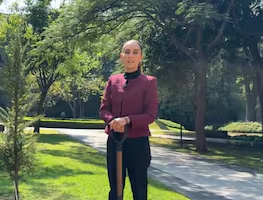Más Información

Sheinbaum cierra el 2024 con mensaje de Año Nuevo; recuerda legado de AMLO y reafirma continuidad de la 4T

Científicos de la UNAM desarrollan lombricompostaje; una alternativa eficiente para el manejo de heces caninas

Anuncian cierre de oficinas de EU en México por funeral del expresidente Jimmy Carter; citas serán reprogramadas
By Giselle Rodríguez
Mexico City–based architects Lazbent Escobedo and Andrés Soliz Paz transformed MoMA PS1’s courtyard with a suspended canopy of colorful ropes.
The installation, called "Weaving the Courtyard" opened on June 10 and will be dismantled on August 14.
The project by Escobedo Soliz Studio,founded in 2011, won the annual Young Architects Program (YAP) in New York, now in its 17th. edition, that offers emerging architectural talent the opportunity to design and present innovative projects.
“Weaving the Courtyard” is a site-specific architectural intervention using the courtyard’s concrete walls to generate both sky and landscape, with embankments in which platforms of soil and water suggest the appearance of a unique topography. A reflective wading pool stands at the back of the courtyard allowing visitors to cool off in fresh water.
Using the modulation of the holes existing in the concrete by the formwork ties when the walls were originally poured, the architects wove a textured canopy suspended over the courtyard, or a “cloud” made of colorful ropes. Variations of density are visible throughout the weaving, inviting visitors to interact and occupy spaces for different periods of time. The woven cloud provides shade to the visitors below while recasting the courtyard in a bright colored web.
The architects described the construction as “neither an object nor a sculpture standing in the courtyard, but a series of simple, powerful actions that generate new and different atmospheres.”
Through explorations in materials and construction techniques, demographic research, and the integration from the community in the design process, Escobedo Solíz Studio designs projects that aim at a deep sense of site-specificity. They describe their theoretical framework as one in which architecture is not only registered as a product but also as a catalyst to improve a given territory where restrictions become opportunities and preexistent conditions of site, climate, and locality should encourage new and practical solutions.








